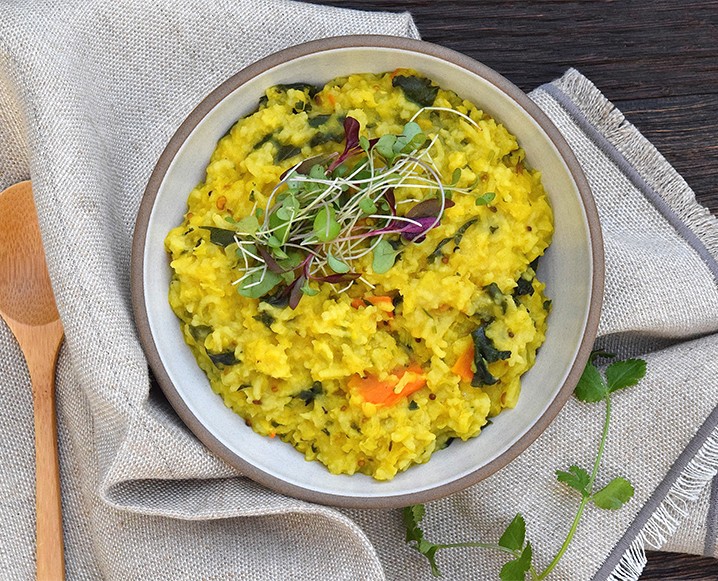Looking for a spicy plant-based and warming Indian dish? Look no further! Check out this tasty recipe below.
NATASHA'S SIMPLE KITCHARI
What is Kitchari? Kitchari is here to help you grow spiritually, physically, and emotionally. Kitchari has been consumed for over 10,000 years in India. It's fed to babies, seniors, the sickly; and eaten by those who have no appetite, have returned from a long trip or are simply on a budget.
Kitchari is also used as a cleansing method where you actually get to EAT. Now that's my kinda cleanse. To do this cleanse you eat kitchari for each meal, 3 or 4 times a day, until you are full. Remember, full doesn't mean stuffed. Full means 1/3 food, 1/3 water and 1/3 space. Yes, veggies partially count as water. No deprivation, no starvation, just pure grounded goodness. If you can't stomach kitchari in the morning feel free to eat a simple bowl of oatmeal (with no toppings!) instead and resume eating kitchari for your other meals. I'll do a kitchari cleanse mono-diet a couple times a year; spring and fall or whenever I feel like I need a reset which most of the time means after the holidays, too! I promise if you do this cleanse you will feel grounded, balanced and deeply nourished.
Did you know that it is statistically proven that juice cleanses actually HARM our bodies. Why is this fad still around! I don't get it. Intense food deprivation cleanses okay for you but are not sustainable unless you are following all of the proper rules (enema's, relaxation, reflection, etc.). I personally don't go there, so kitchari is the perfect cleanse food cleanse for me and it's a great place to start for anybody. The mix of rice and dahl in kitchari contain 20 essential amino acids which create a perfect protein to sustain your body. You can also eat this as a main or side dish, even if you're not cleansing... it's that tasty.
If you're curious to find out more about kitchari sign up for a free call and we can chat. I'd be happy to guide you through my experience with cleansing and Ayurveda by providing you with helpful steps, tips, and insight.
Natasha's Simple Kitchari Recipe
Prep time: 6-12 hours (includes soaking time)
Cook time: 30 mins
Serves: 4-6 servings
INGREDIENTS
½ cup split mung beans (link at bottom of post)
¼ cup organic basmati rice (or quinoa if you have a kapha imbalance)
1 3x2 inch strip of kombu seaweed, cut into small pieces, or a few pieces of dried wakame
6-8 cups of filtered water
3-4 cups fresh, organic and seasonal veggies (use at least one green veggie such as spinach or kale and one orange or root vegetable such as carrot, sweet potato or squash)
1-2 Tbsp of CCF blend (made by grinding equal parts of cumin, coriander and fennel seed or by mixing the pre-ground spices)
⅛ tsp asafoetida/hing (not gluten-free, add extra ginger if you are gluten sensitive)
1 Tbsp minced fresh ginger root
1 tsp turmeric powder
1 cup loosely packed chopped, fresh organic cilantro
2-3 Tbsp ghee (Vegans can use coconut oil in the warmer months or sesame oil in the cooler months use less ghee if you have kapha imbalance, lots of accumulation, or excess weight).
½ - 1 tsp rock salt
INSTRUCTIONS
1. Soak the grain and split mung beans (I don’t really measure I just do a 2:1 ratio of beans to rice) overnight or between 6-12 hours.
2. Rinse the grain and mung beans until the water runs clear then put them in a big pot with the seaweed and water enough to cover by at least an inch or 2 (about 3 cups of water depending on your pot).
3. Boil until soft, about 15-20 minutes. Chop veggies and cilantro and grind spices (if using whole spices. You can also roast them before grinding to enhance the flavors) as the rice and beans cook.
4. Add the veggies (keep kale or quick-cooking veggies out for now), add 2 more cups of water and cover. Cook 3-5 minutes or so until the water boils veggies are starting to soften. Add more water and adjust temperature as needed.
5. Once veggies start to soften, add the minced ginger, and spices (cumin, coriander, fennel, asafoetida and turmeric). When making a warming kitchari in the fall or winter I’ll add a little black pepper and a dash of cinnamon too, maybe some raisins.
6. Add the kale, spinach or other quick-cooking veggies and the fresh cilantro. Stir.
7. Add ghee or oil (or neither) and rock salt.
8. Turn off heat, and serve with microgreens/fresh cilantro and a wedge of lime or chutney.
Try this out and if you don't like these spices then go ahead and use your favorites. You can use italian spices, Mediterranean spices, whatever! Let your creativity flow. Share this recipe with a friend! It's always best to cleanse with an accountability partner.
If the list of ingredients stresses you out you can purchase a hand-dandy Kitchari kit here!





